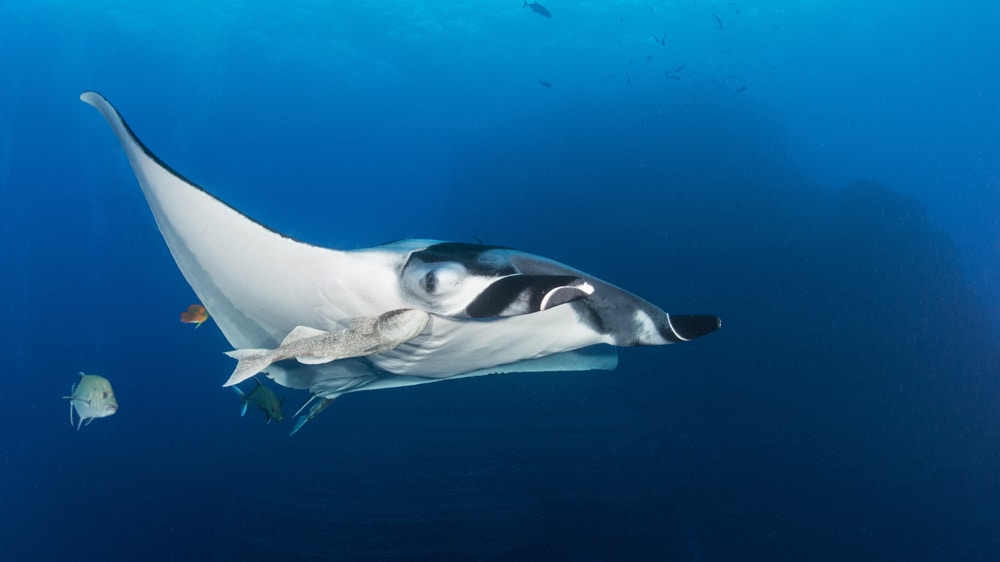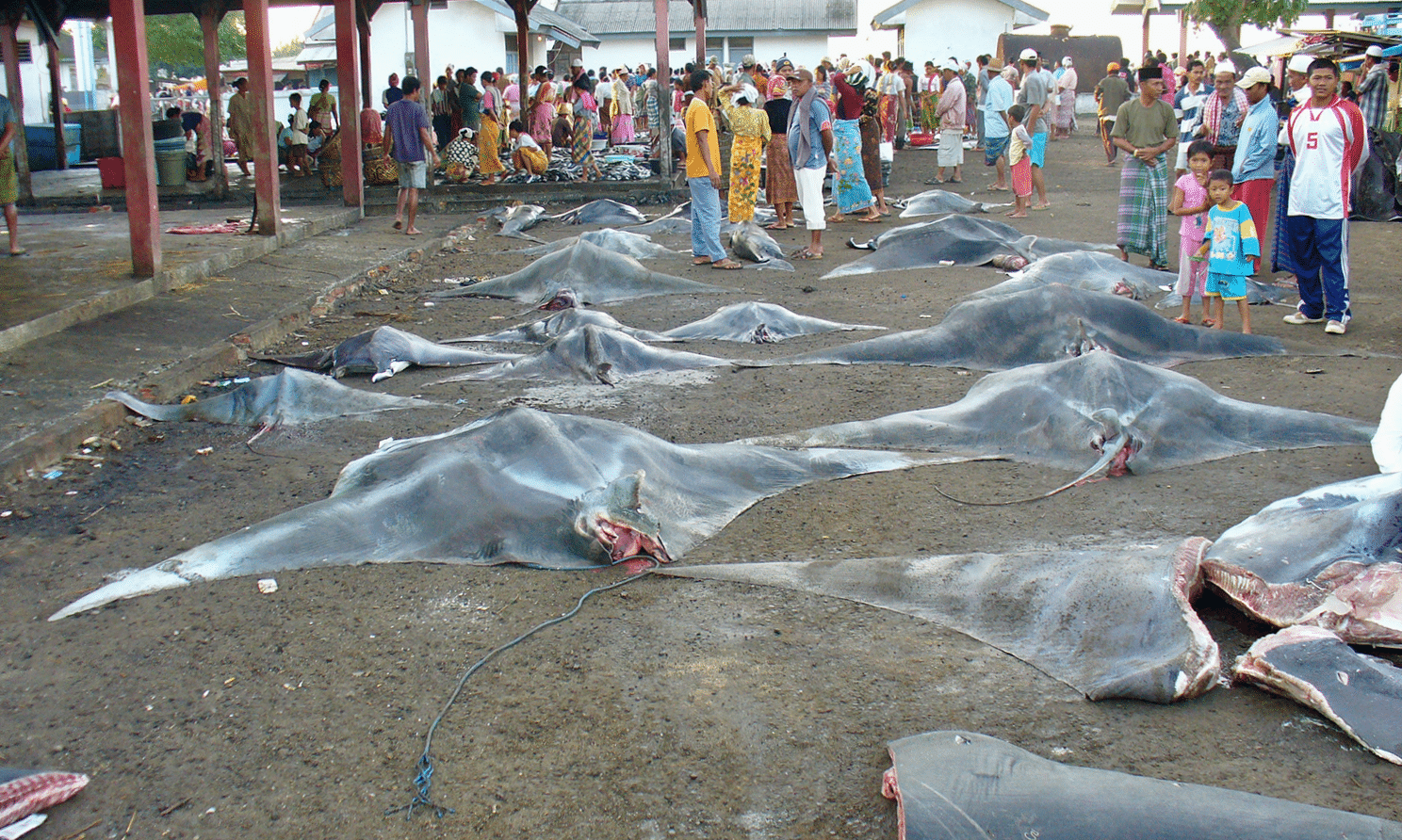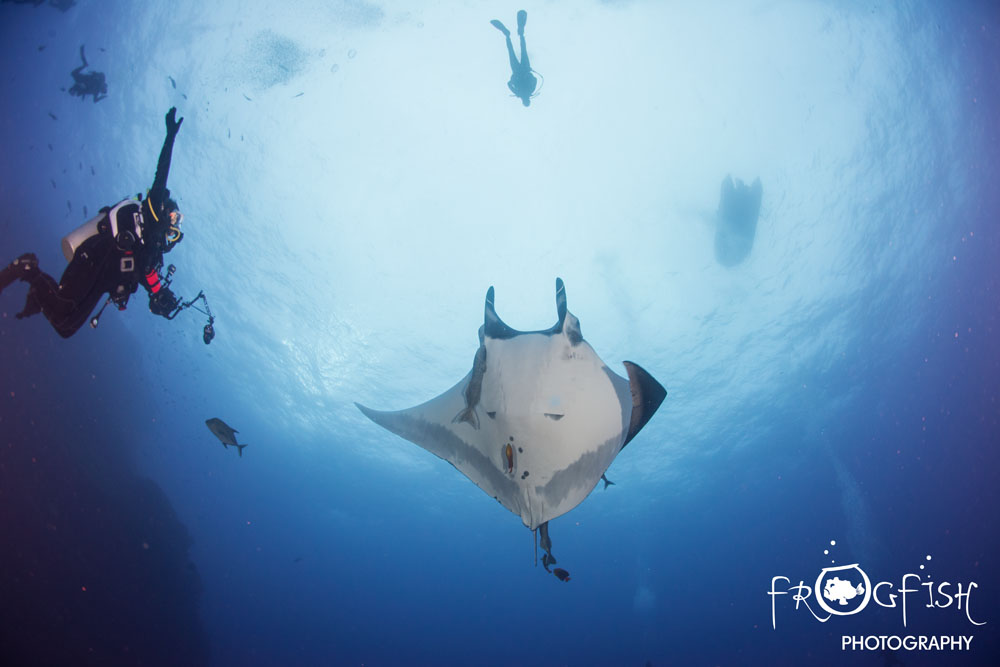Marine Life & Conservation
Giant Manta listed as Endangered

 The conservation status of the giant (or oceanic) manta ray (Mobula birostris) has been uplisted today to Endangered on the International Union for the Conservation of Nature (IUCN) Red List of Threatened Species. An endangered listing is reserved for species with grave conservation concerns. Today’s announcement serves to confirm what we have long suspected – this gentle marine giant is finding it hard to cope with intensifying anthropogenic pressures around the globe. The giant manta ray now joins over 16,000 endangered species to be assessed with this serious threat level. At this stage, 30% of sharks and rays are now threatened with extinction.
The conservation status of the giant (or oceanic) manta ray (Mobula birostris) has been uplisted today to Endangered on the International Union for the Conservation of Nature (IUCN) Red List of Threatened Species. An endangered listing is reserved for species with grave conservation concerns. Today’s announcement serves to confirm what we have long suspected – this gentle marine giant is finding it hard to cope with intensifying anthropogenic pressures around the globe. The giant manta ray now joins over 16,000 endangered species to be assessed with this serious threat level. At this stage, 30% of sharks and rays are now threatened with extinction.
The announcement marks the end of a devastating two decades for this species. Targeted for their gill plates – which they use to filter feed on small zooplankton from the water column – the unrelenting and increasing demand for their body parts has fueled both existing and emerging target fisheries. The relatively new Asian-based trade seems to be impacting the giant manta more than other species of manta ray, with the unsustainable harvesting decimating their populations across the globe.
Dr. Andrea Marshall, co-founder of the Marine Megafauna Foundation (MMF), who lead-authored this newest assessment for the IUCN, has been involved in their assessments since 2003. “The giant manta ray is a classic example of a species that is quickly succumbing to human-induced pressures. When we first assessed manta rays in 2003 there simply was not enough information on the species to determine their conservation status and they were listed as ‘Data Deficient’, but on each of the subsequent assessments, their conservation status increased steadily from Near-Threatened, to Vulnerable and now to Endangered. Their current status is a direct result of unsustainable pressure from fishing, which now threatens to destabilize their populations across the globe.”
To curb the burgeoning trade in their body parts to Asia and to encourage more comprehensive conservation strategies for their populations around the world, the giant manta ray was listed on two of the most important global conservation treaties, the Convention on Migratory Species (CMS) in 2011 and the Convention on the International Trade in Endangered Species (CITES) in 2013.
Sadly, their numbers have continued to decline. “Manta rays simply cannot withstand such pressures on their populations,” Dr. Marshall explains. “They have an extremely conservative reproductive strategy. They reach sexual maturity relatively late in life, they give birth to a single offspring every few years in the wild, they do not look after or defend their young and the offspring themselves are vulnerable when they are small and may not survive. In other words, as a species, they simply cannot reproduce fast enough to build back their numbers once they are depleted.”
This iconic species is not only extremely important from an ecological perspective, giant mantas also provide vast economic benefits to tourism industries around the world. “Interactions with manta rays are highly sought after by dive and snorkel tourists globally and contribute millions of dollars to tourism economies each year, particularly in developing nations. At this pivotal time, recognizing their economic value may help to encourage the protection of this enigmatic and now endangered species” explained Dr. Stephanie Venables, a Senior Scientist and manta ray expert at MMF.
The giant manta ray was only formally described (the process of gathering enough scientific evidence to provide a taxonomic description of a newly discovered species) by Dr. Marshall and colleagues in 2009. At the time it was one of the largest species to be described in our oceans and the announcement was met with excitement around the globe. The discovery was covered by the BBC that year in the first-ever documentary on manta rays.
“It is such an honor to have been able to study and describe this species. The realization that the giant manta ray is now in danger of extinction is a hard pill to swallow”, Dr. Marshall admits. “We are still busy learning about this extraordinary creature and we have only scratched the surface. There is so much more we need to understand, but at this stage, we have put that all aside in favor of protecting the last remaining populations of giant mantas across the globe.”
For more information on the work of the Marine Megafauna Foundation visit their website by clicking here.
Blogs
Invitation from The Ocean Cleanup for San Francisco port call

6 years ago, The Ocean Cleanup set sail for the Great Pacific Garbage Patch with one goal: to develop the technology to be able to relegate the patch to the history books. On 6 September 2024, The Ocean Cleanup fleet returns to San Francisco bringing with it System 03 to announce the next phase of the cleanup of the Great Pacific Garbage Patch and to offer you a chance to view our cleanup system up-close and personal.
We look forward to seeing you there.
To confirm your presence, please RSVP to press@theoceancleanup.com
PROGRAM
Join The Ocean Cleanup as our two iconic ships and the extraction System 03 return to San Francisco, 6 years and over 100 extractions after we set sail, to create and validate the technology needed to rid the oceans of plastic.
Our founder and CEO, Boyan Slat, will announce the next steps for the cleanup of the Great Pacific Garbage Patch. Giving you a chance to view our cleanup system and the plastic extracted.
Hear important news on what’s next in the mission of The Ocean Cleanup as it seeks to make its mission of ridding the world’s oceans of plastic an achievable and realistic goal.
Interviews and vessel tours are available on request.
PRACTICALITIES
Date: September 6, 2024
Press conference: 12 pm (noon)
Location: The Exploratorium (Google Maps)
Pier 15 (Embarcadero at Green Street), San Francisco, CA
Parking: Visit The Exploratorium’s website for details.
RSVP: press@theoceancleanup.com
Video & photo material from several viewing spots around the bay
We look forward to seeing you there!
ABOUT THE OCEAN CLEANUP
The Ocean Cleanup is an international non-profit that develops and scales technologies to rid the world’s oceans of plastic. They aim to achieve this goal through a dual strategy: intercepting in rivers to stop the flow and cleaning up what has already accumulated in the ocean. For the latter, The Ocean Cleanup develops and deploys large-scale systems to efficiently concentrate the plastic for periodic removal. This plastic is tracked and traced to certify claims of origin when recycling it into new products. To curb the tide via rivers, The Ocean Cleanup has developed Interceptor™ Solutions to halt and extract riverine plastic before it reaches the ocean. As of June 2024, the non-profit has collected over 12 million kilograms (26.4 million pounds) of plastic from aquatic ecosystems around the world. Founded in 2013 by Boyan Slat, The Ocean Cleanup now employs a broadly multi-disciplined team of approximately 140. The foundation is headquartered in Rotterdam, the Netherlands, and opened its first regional office in Kuala Lumpur, Malaysia, in 2023.
Find out more about The Ocean Cleanup at www.theoceancleanup.com.
Marine Life & Conservation
SHARK MONTH ARRIVES AT ROYAL WILLIAM YARD, PLYMOUTH

A shark has been spotted approaching Royal William Yard in Plymouth, much to the surprise of swimmers, paddleboarders and onlookers.
With its distinctive dorsal fin cutting through the water, the sizeable shark swam along the coastline, before turning to head inland towards Firestone Arch at Royal William Yard. The appearance drew a crowd, who were captivated for more than an hour by the unusual sight – and it was all caught on video.
The shark is one of many expected sightings at Royal William Yard over the coming weeks… because today marks the start of Shark Month!
In reality, the ‘shark’ spotted along the Plymouth shoreline was actually a custom-made model, created by the team at Royal William Yard and sailed underwater by Caroline Robertson‑Brown from the Shark Trust, who donned scuba diving gear for the occasion.
The stunt took place to launch Shark Month in style and draw attention to the work of the leading international conservation charity, which is based in Britain’s Ocean City. Spectators were reassured that the water was safe and many entered into the spirit of the performance, swimming or sailing alongside the shark.
Shark Month will take place across Royal William Yard throughout July and will feature an extravaganza of art, entertainment and advocacy for everyone to enjoy. The packed programme of events starts with an art exhibition and ends with a trip on paddleboards with shark experts – with everything from a shark quiz to a Jaws screening in between.
Paul Cox, CEO of the Shark Trust, said: “There are often assumptions and misconceptions when it comes to sharks. This was certainly the case with the shark spotted at Royal William Yard! While the British coastline is home to many species of shark, this was not one of them. However, we’re thrilled it caught people’s attention, because seeing a shark is a special and memorable moment. That is precisely why we want to celebrate these incredible creatures, highlight the need for conservation, and ask for help to safeguard their future.”
For more information about Shark Month at Royal William Yard, visit the Shark Trust Website.
Images and video: Jay Stone
-

 Blogs2 months ago
Blogs2 months agoDiving With… Nico, Ocean Earth Travels, Indonesia
-

 News1 month ago
News1 month agoMurex Bangka Announce New Oceanfront Cottages & Beachfront Dining
-

 Blogs2 months ago
Blogs2 months agoA new idea in freediving from RAID
-

 Marine Life & Conservation1 month ago
Marine Life & Conservation1 month agoIceland issue millionaire whale hunter a licence to murder 128 vulnerable fin whales
-

 Marine Life & Conservation2 months ago
Marine Life & Conservation2 months agoThe Shark Trust Great Shark Snapshot is back
-

 News3 months ago
News3 months agoCharting New Waters; NovoScuba Goes Global with the Launch of their Revolutionary Dive Training Agency!
-

 Gear News1 month ago
Gear News1 month agoNew Suunto Ocean – a dive computer and GPS sports watch in one for adventures below and above the surface
-

 Marine Life & Conservation Blogs2 months ago
Marine Life & Conservation Blogs2 months agoBook Review: Plankton
















